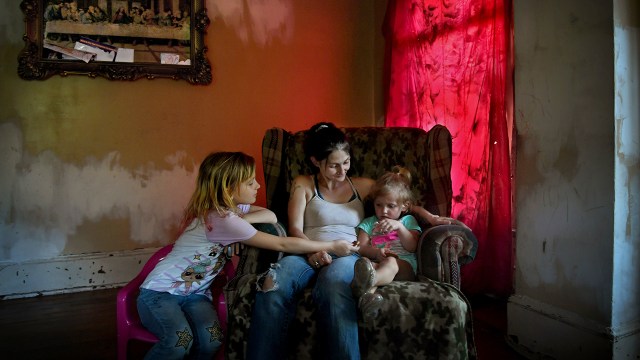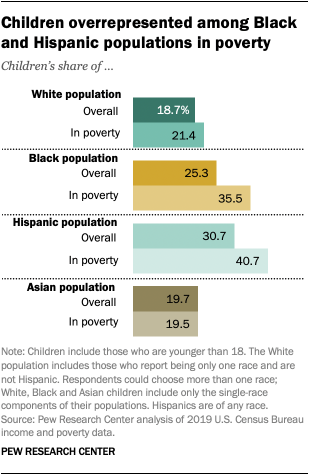
Before the coronavirus outbreak sent the U.S. economy into a recession, the share of American children living in poverty was on a downward trajectory, reaching record lows across racial and ethnic groups, according to a new Pew Research Center analysis of U.S. Census Bureau data.
In 2019, the year with the most recently available data, 14% of children under age 18, or 10.5 million children, were living in poverty, down from 22%, or 16.3 million, in 2010. All major racial and ethnic groups saw declines since 2010, but the greatest decreases were in the shares of Black and Hispanic children living in poverty. About two-in-ten Hispanic children (21%) were living in poverty in 2019, down from 35% in 2010. In 2019, 26% of Black children were impoverished, dropping from 39% in 2010. Even so, Black and Hispanic children were still about three times as likely as Asian (7%) and White (8%) children to be living in poverty.
[chart id=”380520″]
This post is based on Pew Research Center analysis of U.S. Census Bureau data on poverty in the United States, which is derived from the Current Population Survey Annual Social and Economic Supplements (ASEC).
The Census Bureau uses a set of dollar value thresholds that vary by family size and composition to determine who is in poverty. These poverty thresholds are updated annually for inflation using the Consumer Price Index for All Urban Consumers (CPI-U), and do not vary geographically. In 2019, poverty was defined as living in a household with an annual income below $25,926 for a family of four with two related children.
For this analysis, children include only those who are younger than 18. The racial and ethnic groups presented by the Census Bureau are not mutually exclusive. White children refers to non-Hispanic White children. But Black and Asian children include both their Hispanic and non-Hispanic components. Hispanic children are of any race. Before 2002, Asian children include Pacific Islanders.
The COVID-19 outbreak has affected data collection efforts by the U.S. government in its surveys, especially limiting in-person data collection. This resulted in a 10 percentage point decrease in the response rate for the March 2020 ASEC. It is possible that some measures of poverty and racial and ethnic composition are affected by these changes in data collection. For more information, see the Census Bureau’s report on the pandemic’s effect on survey response.
For more information on the source of the data and accuracy of poverty estimates, see the Census Bureau’s technical document on the CPS ASEC.
The number of impoverished children also declined across racial and ethnic groups. In particular, the numbers of poor Black and White children reached new lows in 2019 (each around 3 million). While there are about as many White children as Black children living in poverty, it’s worth noting that there are more than three times as many White children as Black children in the U.S.
[chart id=”380521″]
The greatest decline was in the number of Hispanic children living in poverty. In 2019, 3.9 million Hispanic children were living in poverty, down from 6.1 million impoverished Hispanic children nearly a decade earlier. But there are still more Hispanic children in poverty than any other racial or ethnic group, which has been the case since at least 2007. This is probably because Hispanics are the largest and the youngest racial or ethnic minority population in the U.S. and because the Hispanic child poverty rate is relatively high (21%).
Overall, children are overrepresented among America’s impoverished population. Some 22% of the U.S. population are children, but those younger than 18 represent 31% of all Americans living in poverty.
Black and Hispanic children are particularly overrepresented. Black children represent a quarter of the Black population but 35% of all Black people living in poverty. And Hispanic children are 31% of the total Hispanic population but represent 41% of all impoverished Hispanics. In comparison, children represent about equal shares of total Asian and White populations and of impoverished Asians and Whites.
Note: This is an update of a post originally published on July 14, 2015.

